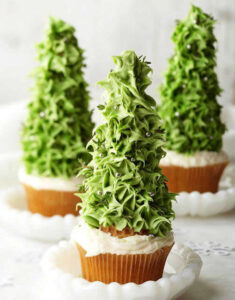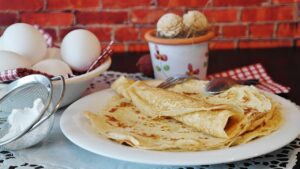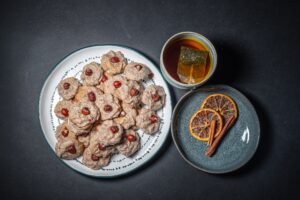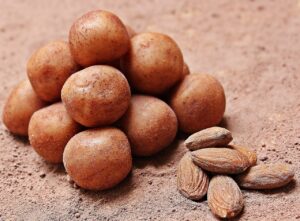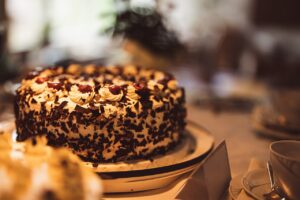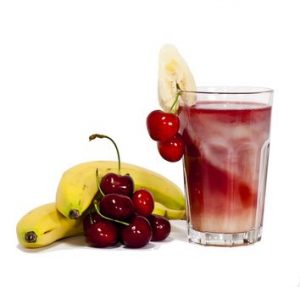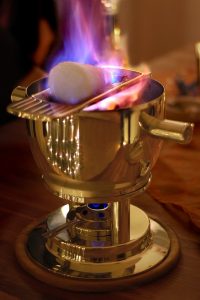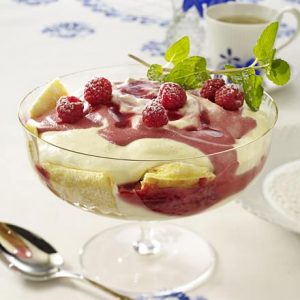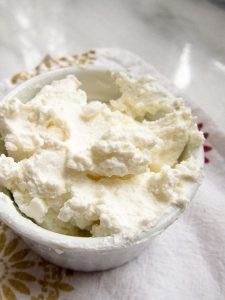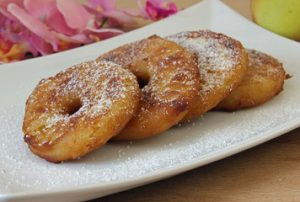Ingredients:*-*-*-*-*-*-*-*-*-*-*-*-*-*-*-*-*-*-*-*-*-* 150 g butter, softened150 g caster sugar3 eggs, beaten150 g self-raising flour, sifted1 tsp vanilla extract1 tbsp milk For the frosting 200 g butter, at room temperature250 g icing sugar1 tsp vanilla extract1 tbsp milkgreen food coloring To decorate: silver balls, sugar … [Read more...]
Swabian Pancakes
Swabian Pancakes, also known as "Schwäbische Pfannkuchen," are a delightful dish hailing from the Swabian region of Southern Germany. This versatile and delicious recipe is perfect for both savory and sweet variations, making it a beloved staple in German households. Ingredients: 200g all-purpose flour200ml milk4 large eggsA pinch of salt2 … [Read more...]
Haselnussmakronen (German Hazelnut Macaroons): A Delightful Treat from Germany
The aroma of freshly baked Haselnussmakronen, or German hazelnut macaroons, is enough to evoke a sense of warmth and nostalgia. These delightful treats, not to be confused with French macarons, are a staple in German baking, particularly during the festive season. Rich in flavor and simple in preparation, Haselnussmakronen embody the essence of … [Read more...]
Authentic Marzipan Kartoffeln (Marzipan Potatoes) Recipe
Marzipan Kartoffeln, charmingly known as Marzipan Potatoes, are a quintessential German confectionery treat, especially beloved during the Christmas season. These sweet, potato-shaped goodies are not only a festive delight but also an artistic expression of the traditional marzipan craft. With origins dating back to the 15th century, marzipan has … [Read more...]
The History of Black Forest Cake: A Delightful Journey Through Time
The Black Forest cake, with its layers of chocolate sponge cake, luscious cherries, whipped cream, and chocolate shavings, has become a beloved dessert enjoyed by millions worldwide. This iconic confection is not only a delight to the taste buds but also holds a rich history that adds to its allure. In this article, we will take a journey through … [Read more...]
Favorite German Drinks to Try
No matter how hot the weather, Germany has got you covered! 1. Schorle is a beverage where sparkling mineral water and juice are mixed, comparable to a spritzer. This is as refreshing as a soft drink on a hot day, but with less calories and sugar. The most common varieties of Schorle are Apfelschorle, apple juice mixed with sparkling water, … [Read more...]
Feuerzangenbowle – Glühwein with a Twist!
Feuerzangenbowle is a traditional German alcoholic drink for which a rum-soaked sugarloaf is set on fire and drips into mulled wine. It is often part of a Christmas or New Year's Eve tradition. The name translates literally to "fire-tongs punch". Glühwein (spiced mulled wine) is quite popular during the winter months in Germany. But if you are … [Read more...]
Lübecker Plettenpudding
A dessert that really tastes like Sunday. Plettenpudding is a kind of trifle with vanilla pudding and raspberries. This dessert is featured in one of Germany's most popular novels, the family epic The Buddenbrooks by Thomas Mann. The Lübeck-born author won the Nobel Prize for literature for his first novel which he wrote in his … [Read more...]
How to Make German Quark
Quark is a traditional, creamy, unripened cheese tracing its origin to German-speaking and eastern European countries. Quark is said to be a cross between yogurt and cottage cheese. This fresh, soft, white cheese is prepared from pasteurised cow's milk with a small amount of acid added to achieve a good, firm curd. However, traditional quark is … [Read more...]
Apfelküchle – German Apple Fritters
Few things say "comfort food" quite like a warm, cinnamon-scented apple fritter straight from the pan. Apfelküchle, or German apple fritters, are a beloved treat that has been warming hearts and satisfying sweet cravings for generations. Traditionally made with sliced apples dipped in batter and fried to golden perfection, Apfelküchle is often … [Read more...]
